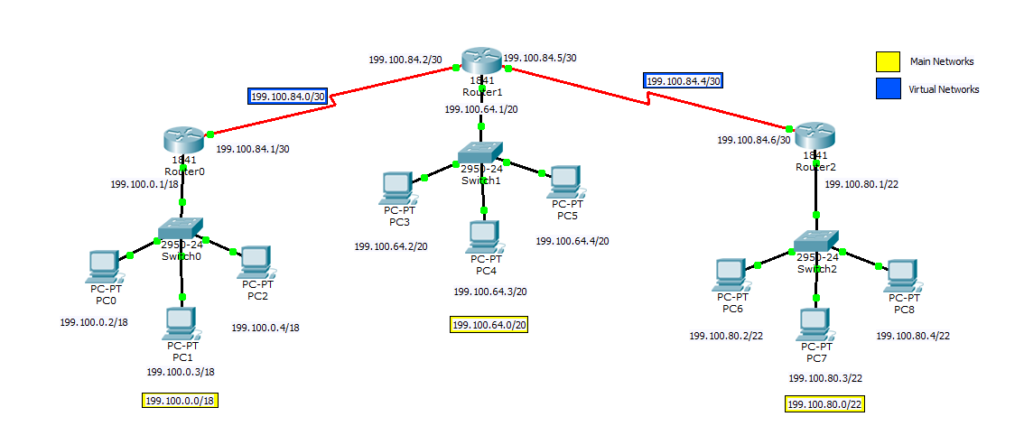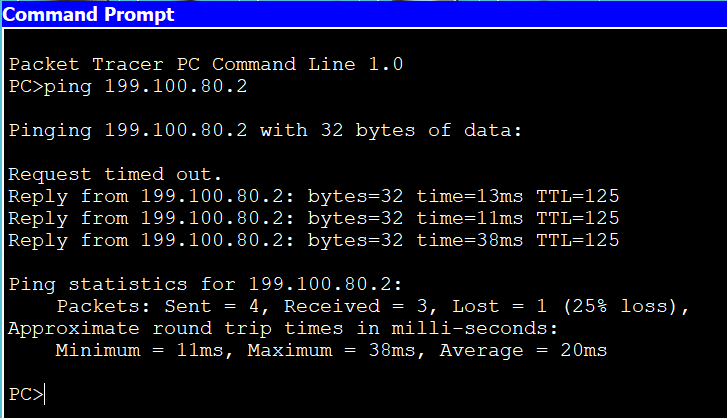In this lab, I will show you Static- Combination of Class C and Class B on 3 Routers
Table of Contents
VLSM
Given Network: 199.100.0.0
Required host on Router 1= 16,000
Required host on Router 2= 3000
Required host on Router 3= 1000

R1<=16,000
16,000<=2n – 2
16,000<=214 – 2
16,000<=16,384 – 2
16,000<=16,382
Total number of network bits = 32
32 – n = 32 – 14 = 18 (CIDR value of Router 1 i.e. Given network)
i.e. 199.100.0.0/18
N.S.M = 11111111.11111111.11000000.00000000
= 255.255.192.0
Block Size = 256 – N.S.M
= 256 – 192 = 64
Note: Add this block size in given network so that we can get our new network for Router 2.
so the new network is 199.100.64.0/?
Now find FVH, LVH and Broadcast address
| Given Network | 199 | 100 | 0 | 0 |
| First Valid Host-FVH | 199 | 100 | 0 | 1 |
| Last Valid Host-LVH | 199 | 100 | 63 | 254 |
| Broadcast | 199 | 100 | 63 | 255 |
| New Network | 199 | 100 | 64 | 0 |
R2<=3000
3000<=2n – 2
3000<=212 – 2
3000<=4096 – 2
3000<=4094
Total number of network bits = 32
32 – n = 32 – 12 = 20 (CIDR value of Router 2 i.e. New network)
i.e. 199.100.64.0/20
N.S.M = 11111111.11111111.11110000.00000000
= 255.255.240.0
Block Size = 256 – N.S.M
= 256 – 240 = 16
Note: Add this block size in given network so that we can get our new network for Router 3.
so the new network is 199.100.80.0/?
Now find FVH, LVH and Broadcast address
| Given Network | 199 | 100 | 64 | 0 |
| First Valid Host-FVH | 199 | 100 | 64 | 1 |
| Last Valid Host-LVH | 199 | 100 | 79 | 254 |
| Broadcast | 199 | 100 | 79 | 255 |
| New Network | 199 | 100 | 80 | 0 |
R3<=1000
1000<=2n – 2
1000<=210 – 2
1000<=1024 – 2
1000<=1022
Total number of network bits = 32
32 – n = 32 – 10 = 22 (CIDR value of Router 3 i.e. New network)
i.e. 199.100.80.0/22
N.S.M = 11111111.11111111.11111100.00000000
= 255.255.252.0
Block Size = 256 – N.S.M
= 256 – 252 = 4
Note: Add this block size in given network so that we can get our new network for Router 1 and Router 2 (Virtual Network).
so the new network is 199.100.84.0/?
Now find FVH, LVH and Broadcast address
| Given Network | 199 | 100 | 80 | 0 |
| First Valid Host-FVH | 199 | 100 | 80 | 1 |
| Last Valid Host-LVH | 199 | 100 | 83 | 254 |
| Broadcast | 199 | 100 | 83 | 255 |
| New Network | 199 | 100 | 84 | 0 |
Router 1 and Router 2 <= 2 (we required only two IP to connect two routers)
2 <= 2n – 2
2 <= 22 – 2
2 <= 4 – 2
2 <= 2
Total number of network bits = 32
32 – n = 32 – 2 = 30 (CIDR of Virtual network (R1&R2))
i.e. 199.100.84.0/30
N.S.M = 11111111.11111111.11111111.11111100
= 255.255.255.252
Block Size = 256 – N.S.M
= 256 – 252 = 4
Note: Add this block size in given network so that we can get our new network for Router 2 and Router 3 (Virtual Network). so the new network is 199.100.84.4/30?
Now find FVH, LVH and Broadcast address
| Given Network | 199 | 100 | 84 | 0 |
| First Valid Host-FVH | 199 | 100 | 84 | 1 |
| Last Valid Host-LVH | 199 | 100 | 84 | 2 |
| Broadcast | 199 | 100 | 84 | 3 |
| New Network | 199 | 100 | 84 | 4 |
2 and Router 3 <= 2 (we required only two IP to connect two routers)
2 <= 2n – 2
2 <= 22 – 2
2 <= 4 – 2
2 <= 2
Total number of network bits = 32
32 – n = 32 – 2 = 30 (CIDR of Virtual network (R2&R3))
i.e. 199.100.84.4/30
N.S.M = 11111111.11111111.11111111.11111100
= 255.255.255.252
Block Size = 256 – N.S.M
= 256 – 252 = 4
Note: Add this block size in given network so that we can get our new network for Router 4. This network can be used in future.
so the new network is 199.100.84.8/?
Now find FVH, LVH and Broadcast address
| Given Network | 199 | 100 | 84 | 4 |
| First Valid Host-FVH | 199 | 100 | 84 | 5 |
| Last Valid Host-LVH | 199 | 100 | 84 | 6 |
| Broadcast | 199 | 100 | 84 | 7 |
| New Network | 199 | 100 | 84 | 8 |

Basic Configuration on Router 1
| Router>enable Router#configure terminal Router(config)#hostname R1 R1(config)#interface fastEthernet 0/0 R1(config-if)#ip address 199.100.0.1 255.255.192.0 R1(config-if)#no shutdown R1(config-if)#exit R1(config)#interface serial 0/0/0 R1(config-if)#ip address 199.100.84.1 255.255.255.252 R1(config-if)#clock rate 64000 R1(config-if)#no shutdown R1(config-if)#exit R1(config)#exit R1#write |
Basic Configuration on Router 2
| Router>enable Router#configure terminal Router(config)#hostname R2 R2(config)#interface fastEthernet 0/0 R2(config-if)#ip address 199.100.64.1 255.255.240.0 R2(config-if)#no shutdown R2(config-if)#exit R2(config)#interface serial 0/1/0 R2(config-if)#ip address 199.100.84.2 255.255.255.252 R2(config-if)#no shutdown R2(config-if)#exit R2(config)#interface serial 0/0/0 R2(config-if)#ip address 199.100.84.5 255.255.255.252 R2(config-if)#clock rate 64000 R2(config-if)#no shutdown R2(config-if)#exit R2(config)#exit R2#write |
Basic Configuration on Router 3
| Router>enable Router#configure terminal Router(config)#hostname R3 R3(config)#interface fastEthernet 0/0 R3(config-if)#ip address 199.100.80.1 255.255.252.0 R3(config-if)#no shutdown R3(config-if)#exit R3(config)#interface serial 0/1/0 R3(config-if)#ip address 199.100.84.6 255.255.255.252 R3(config-if)#no shutdown R3(config-if)#exit R3(config)#exit R3#write |
Static Configuration on Router 1
| R1>enable R1#configure terminal R1(config)#ip route 199.100.64.0 255.255.240.0 199.100.84.2 R1(config)#ip route 199.100.80.0 255.255.252.0 199.100.84.2 R1(config)# R1(config)#ip route 199.100.84.0 255.255.255.252 199.100.84.2 R1(config)#ip route 199.100.84.4 255.255.255.252 199.100.84.2 R1(config)#exit R1#write |
Static Configuration on Router 2
| R2>enable R2#configure terminal R2(config)#ip route 199.100.0.0 255.255.192.0 199.100.84.1 R2(config)#ip route 199.100.80.0 255.255.252.0 199.100.84.6 R2(config)# R2(config)#ip route 199.100.84.0 255.255.255.252 199.100.84.1 R2(config)#ip route 199.100.84.4 255.255.255.252 199.100.84.6 R2(config)#exit R2#write |
Static Configuration on Router 3
| R3>enable R3#configure terminal R3(config)#ip route 199.100.0.0 255.255.192.0 199.100.84.5 R3(config)#ip route 199.100.64.0 255.255.240.0 199.100.84.5 R3(config)# R3(config)#ip route 199.100.84.0 255.255.255.252 199.100.84.5 R3(config)#ip route 199.100.84.4 255.255.255.252 199.100.84.5 R3(config)#exit R3#write |
Verification on Router 1
| R1#show ip route C 199.100.0.0/18 is directly connected, FastEthernet0/0 S 199.100.64.0/20 [1/0] via 199.100.84.2 S 199.100.80.0/22 [1/0] via 199.100.84.2 199.100.84.0/30 is subnetted, 2 subnets C 199.100.84.0 is directly connected, Serial0/0/0 S 199.100.84.4 [1/0] via 199.100.84.2 |
Verification on Router 2
| R2#show ip route S 199.100.0.0/18 [1/0] via 199.100.84.1 C 199.100.64.0/20 is directly connected, FastEthernet0/0 S 199.100.80.0/22 [1/0] via 199.100.84.6 199.100.84.0/30 is subnetted, 2 subnets C 199.100.84.0 is directly connected, Serial0/1/0 C 199.100.84.4 is directly connected, Serial0/0/0 |
Verification on Router 3
| R3#show ip route S 199.100.0.0/18 [1/0] via 199.100.84.5 S 199.100.64.0/20 [1/0] via 199.100.84.5 C 199.100.80.0/22 is directly connected, FastEthernet0/0 199.100.84.0/30 is subnetted, 2 subnets S 199.100.84.0 [1/0] via 199.100.84.5 C 199.100.84.4 is directly connected, Serial0/1/0 |



